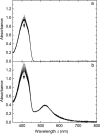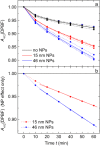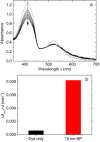Singlet Oxygen Generation by Laser Irradiation of Gold Nanoparticles
- PMID: 27239247
- PMCID: PMC4878812
- DOI: 10.1021/acs.jpcc.6b02005
Singlet Oxygen Generation by Laser Irradiation of Gold Nanoparticles
Abstract
The formation of singlet oxygen by irradiation of gold nanoparticles in their plasmon resonance band with continuous or pulsed laser light has been investigated. Citrate-stabilized nanoparticles were found to facilitate the photogeneration of singlet oxygen, albeit with low quantum yield. The reaction caused by pulsed laser irradiation makes use of the equilibrated hot electrons that can reach temperatures of several thousand degrees during the laser pulse. Although less efficient, continuous irradiation, which acts via the short-lived directly excited primary "hot" electrons only, can produce enough singlet oxygen for photodynamic cancer therapy and has significant advantages for practical applications. However, careful design of the nanoparticles is needed, since even a moderately thick capping layer can completely inhibit singlet oxygen formation. Moreover, the efficiency of the process also depends on the nanoparticle size.
Conflict of interest statement
The authors declare no competing financial interest.
Figures






Similar articles
-
Light-induced generation of singlet oxygen by naked gold nanoparticles and its implications to cancer cell phototherapy.Small. 2013 Dec 20;9(24):4130-4. doi: 10.1002/smll.201301365. Epub 2013 Jul 1. Small. 2013. PMID: 23813944
-
A comprehensive review on singlet oxygen generation in nanomaterials and conjugated polymers for photodynamic therapy in the treatment of cancer.Nanoscale. 2024 Feb 15;16(7):3243-3268. doi: 10.1039/d3nr05801h. Nanoscale. 2024. PMID: 38265094 Review.
-
Effects of light irradiation upon photodynamic therapy based on 5-aminolevulinic acid-gold nanoparticle conjugates in K562 cells via singlet oxygen generation.Int J Nanomedicine. 2012;7:5029-38. doi: 10.2147/IJN.S33261. Epub 2012 Sep 17. Int J Nanomedicine. 2012. PMID: 23055721 Free PMC article.
-
Aggregated gold nanoparticles as photoactivators for the photopolymerization of proteins.J Photochem Photobiol B. 2025 Feb;263:113099. doi: 10.1016/j.jphotobiol.2025.113099. Epub 2025 Jan 7. J Photochem Photobiol B. 2025. PMID: 39787976
-
Inorganic Nanoparticles for Photodynamic Therapy.Top Curr Chem. 2016;370:113-34. doi: 10.1007/978-3-319-22942-3_4. Top Curr Chem. 2016. PMID: 26589507 Review.
Cited by
-
Nanogold Foundry Involving High-Shear-Mediated Photocontact Electrification in Water.Small Sci. 2024 May 9;4(6):2300312. doi: 10.1002/smsc.202300312. eCollection 2024 Jun. Small Sci. 2024. PMID: 40212757 Free PMC article.
-
Recent developments in the use of gold and silver nanoparticles in biomedicine.Wiley Interdiscip Rev Nanomed Nanobiotechnol. 2022 Sep;14(5):e1817. doi: 10.1002/wnan.1817. Epub 2022 Jul 1. Wiley Interdiscip Rev Nanomed Nanobiotechnol. 2022. PMID: 35775611 Free PMC article. Review.
-
Enhancing Singlet Oxygen Generation in Conjugates of Silicon Nanocrystals and Organic Photosensitizers.Front Chem. 2020 Jul 17;8:567. doi: 10.3389/fchem.2020.00567. eCollection 2020. Front Chem. 2020. PMID: 32766208 Free PMC article.
-
Photodynamic and Antibacterial Assessment of Gold Nanoparticles Mediated by Gold (III) Chloride Trihydrate and Sodium Citrate under Alkaline Conditions.Materials (Basel). 2024 Jun 27;17(13):3157. doi: 10.3390/ma17133157. Materials (Basel). 2024. PMID: 38998240 Free PMC article.
-
Delivery of drugs, proteins, and nucleic acids using inorganic nanoparticles.Adv Drug Deliv Rev. 2020;156:188-213. doi: 10.1016/j.addr.2020.06.020. Epub 2020 Jun 29. Adv Drug Deliv Rev. 2020. PMID: 32610061 Free PMC article. Review.
References
LinkOut - more resources
Full Text Sources
Other Literature Sources
